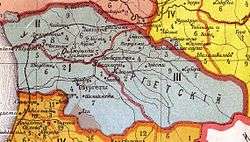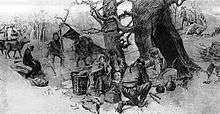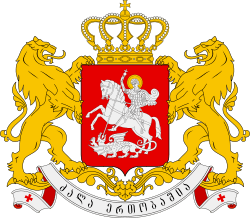Republic of Guria
| Republic of Guria გურიის რესპუბლიკა | |||||||||
|---|---|---|---|---|---|---|---|---|---|
| 1905–1906 | |||||||||
 Guria under the Russian Empire | |||||||||
| Capital | Ozurgeti | ||||||||
| Common languages | Georgian | ||||||||
| Government | Republic | ||||||||
| President | |||||||||
• 1905-1906 | Beniamin Chkhikvishvili | ||||||||
| Historical era | Modern Era | ||||||||
• Independence | 1905 | ||||||||
• Manifest of Bakhvi | 2 November 1905 | ||||||||
• Battle of Nasakirali | February 23, 1905 | ||||||||
• Disestablished | 1906 | ||||||||
| Area | |||||||||
| 2,030 km2 (780 sq mi) | |||||||||
| Currency | Ruble | ||||||||
| |||||||||
| Today part of |
| ||||||||
| History of Georgia |
|---|
 |
|
History by topic |
|
|
The Republic of Guria or the Gurian Peasant Republic was an insurrection that took place in the western Georgian province Guria, against Imperial Russia, prior to and during the Russian Revolution of 1905.
Background
Underdeveloped and rather poor part of the Kutais Governorate, Guria, officially called the Ozurgeti district (Ozurgetsky uyezd), was known not only for its oppositionist stance towards the Russian rule, but also for the unprecedented support for the Social Democratic (Menshevik) Party. The unrest began as the peasants' boycott of the local estate of Prince Machutadze in 1902. The so-called agrarian movement involving landless peasants evolved almost into an overt revolt early in 1903. The peasants stopped paying taxes and refused to work for the landlords. After a harsh official reaction, the peasants initiated a boycott of all government services. By summer, local government in the area had almost completely disintegrated. Nicholas II took no action against Guria throughout 1904, assuming that the cost of dealing with the rebellion would not be justified.
History

After the beginning of the 1905 Revolution, however, the revolt began spreading throughout Georgia and the Gurian revolution proceeded even in a more radical way. The peasants sent away all the authorities, and, nominating their own judges, they organized independent village communities and armed red detachments also known as forest brothers, embodying a whole territory. The Gurian peasant women at village meetings adopted resolutions demanding political equality with men. The revolutionaries largely used terrorism against the Tsarist officers and loyal landlords. By February the whole of Guria was in the power of the revolutionaries, perhaps the world’s first Marxist national-liberation movement.
On February 20, 1905 a Tsarist official warned that the government had lost control of much of the area. In March, the government declared martial law and a force of 10,000 soldiers was sent to the rebellious province. The Gurians offered a fierce resistance to the expedition and General Alikhanov-Avarsky, unable to regain control, had to withdraw in July. Several attempts to negotiate the conflict yielded no result. The Russian forces returned in October, but were severely defeated at Nasakirali. In December 1905 the rebels took control of Ozurgeti, Guria’s chief town. On January 10, 1906 Colonel Krilov’s strong reinforcements of all arms attacked the province and ruthlessly crushed the insurrection putting an end to the “Gurian Republic”.
Bibliography
- S. F. Jones, "Marxism and Peasant Revolt in the Russian Empire: The Case of the Gurian Republic", Slavonic and East European Review 67 (July 1989): 403–34.
- Irakli Makharadze, "Gurian Republic", Azri Publishing, 2016, (Georgian).
- Suny, Ronald Grigor (1994), The Making of the Georgian Nation (Second ed.), Bloomington, Indiana: Indiana University Press, ISBN 978-0-25-320915-3
External links
- Article by Alexandra Kollontai
- Fire and Sword in the Caucasus by Luigi Villari, an account of a European eyewitness
- The Gurian uprising 1905 (in Russian)
